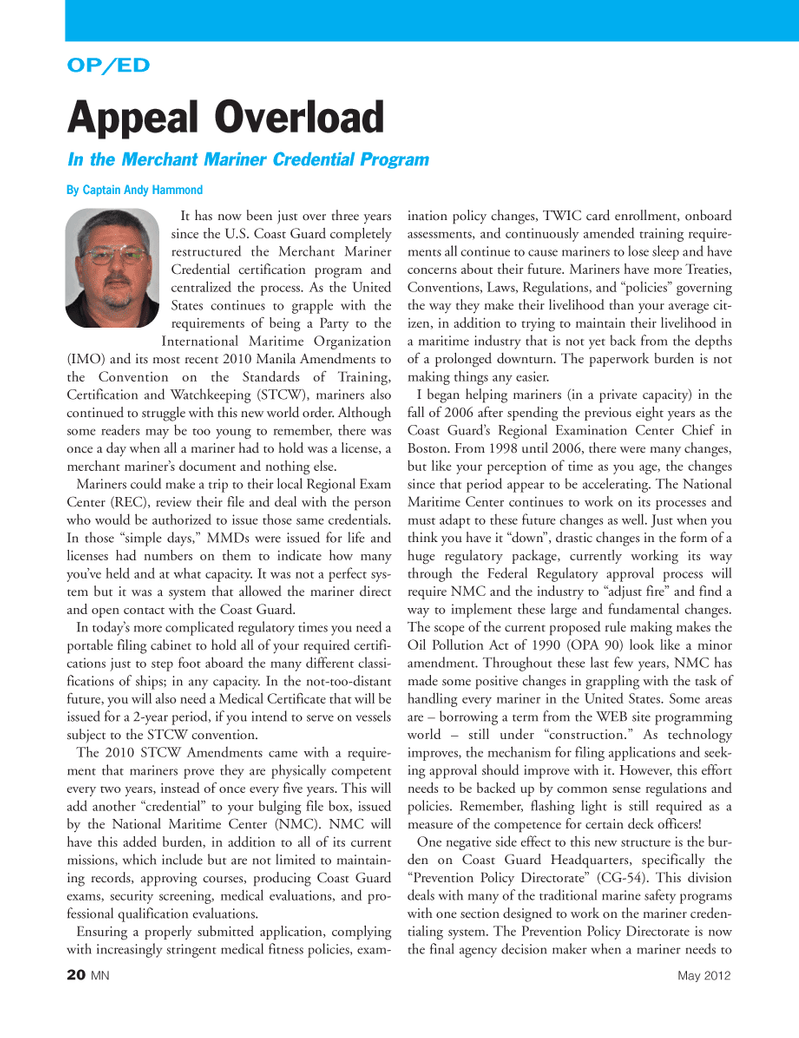
Page 20: of Marine News Magazine (May 2012)
Combat Craft Annual
Read this page in Pdf, Flash or Html5 edition of May 2012 Marine News Magazine
20MNMay 2012It has now been just over three years since the U.S. Coast Guard completely restructured the Merchant Mariner Credential certification program and centralized the process. As the United States continues to grapple with the requirements of being a Party to the International Maritime Organization (IMO) and its most recent 2010 Manila Amendments to the Convention on the Standards of Training, Certification and Watchkeeping (STCW), mariners also continued to struggle with this new world order. Although some readers may be too young to remember, there was once a day when all a mariner had to hold was a license, amerchant mariner?s document and nothing else. Mariners could make a trip to their local Regional Exam Center (REC), review their file and deal with the person who would be authorized to issue those same credentials. In those ?simple days,? MMDs were issued for life and licenses had numbers on them to indicate how many you?ve held and at what capacity. It was not a perfect sys- tem but it was a system that allowed the mariner direct and open contact with the Coast Guard. In today?s more complicated regulatory times you need a portable filing cabinet to hold all of your required certifi- cations just to step foot aboard the many different classi- fications of ships; in any capacity. In the not-too-distant future, you will also need a Medical Certificate that will be issued for a 2-year period, if you intend to serve on vessels subject to the STCW convention. The 2010 STCW Amendments came with a require- ment that mariners prove they are physically competent every two years, instead of once every five years. This will add another ?credential? to your bulging file box, issued by the National Maritime Center (NMC). NMC will have this added burden, in addition to all of its current missions, which include but are not limited to maintain- ing records, approving courses, producing Coast Guard exams, security screening, medical evaluations, and pro- fessional qualification evaluations. Ensuring a properly submitted application, complying with increasingly stringent medical fitness policies, exam- ination policy changes, TWIC card enrollment, onboard assessments, and continuously amended training require- ments all continue to cause mariners to lose sleep and have concerns about their future. Mariners have more Treaties, Conventions, Laws, Regulations, and ?policies? governing the way they make their livelihood than your average cit- izen, in addition to trying to maintain their livelihood in a maritime industry that is not yet back from the depths of a prolonged downturn. The paperwork burden is not making things any easier. I began helping mariners (in a private capacity) in the fall of 2006 after spending the previous eight years as the Coast Guard?s Regional Examination Center Chief in Boston. From 1998 until 2006, there were many changes, but like your perception of time as you age, the changes since that period appear to be accelerating. The National Maritime Center continues to work on its processes and must adapt to these future changes as well. Just when you think you have it ?down?, drastic changes in the form of a huge regulatory package, currently working its way through the Federal Regulatory approval process will require NMC and the industry to ?adjust fire? and find a way to implement these large and fundamental changes.The scope of the current proposed rule making makes the Oil Pollution Act of 1990 (OPA 90) look like a minor amendment. Throughout these last few years, NMC has made some positive changes in grappling with the task of handling every mariner in the United States. Some areas are ? borrowing a term from the WEB site programming world ? still under ?construction.? As technology improves, the mechanism for filing applications and seek- ing approval should improve with it. However, this effort needs to be backed up by common sense regulations and policies. Remember, flashing light is still required as a measure of the competence for certain deck officers! One negative side effect to this new structure is the bur- den on Coast Guard Headquarters, specifically the ?Prevention Policy Directorate? (CG-54). This division deals with many of the traditional marine safety programs with one section designed to work on the mariner creden- tialing system. The Prevention Policy Directorate is now the final agency decision maker when a mariner needs toOP/EDBy Captain Andy HammondAppeal OverloadIn the Merchant Mariner Credential Program MN#5 (18-31):MN 2011 Layouts 5/7/2012 9:52 AM Page 20

 19
19

 21
21
